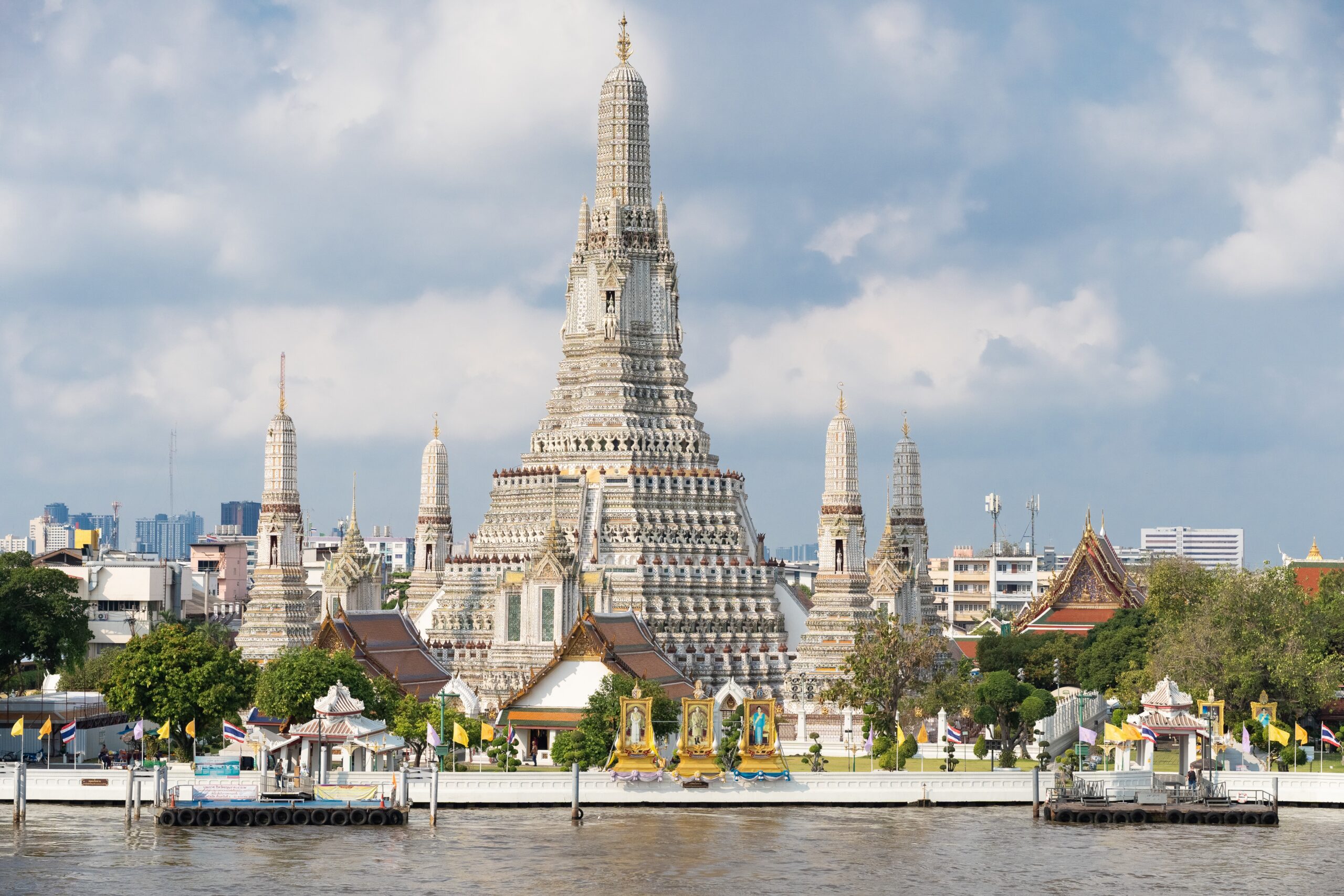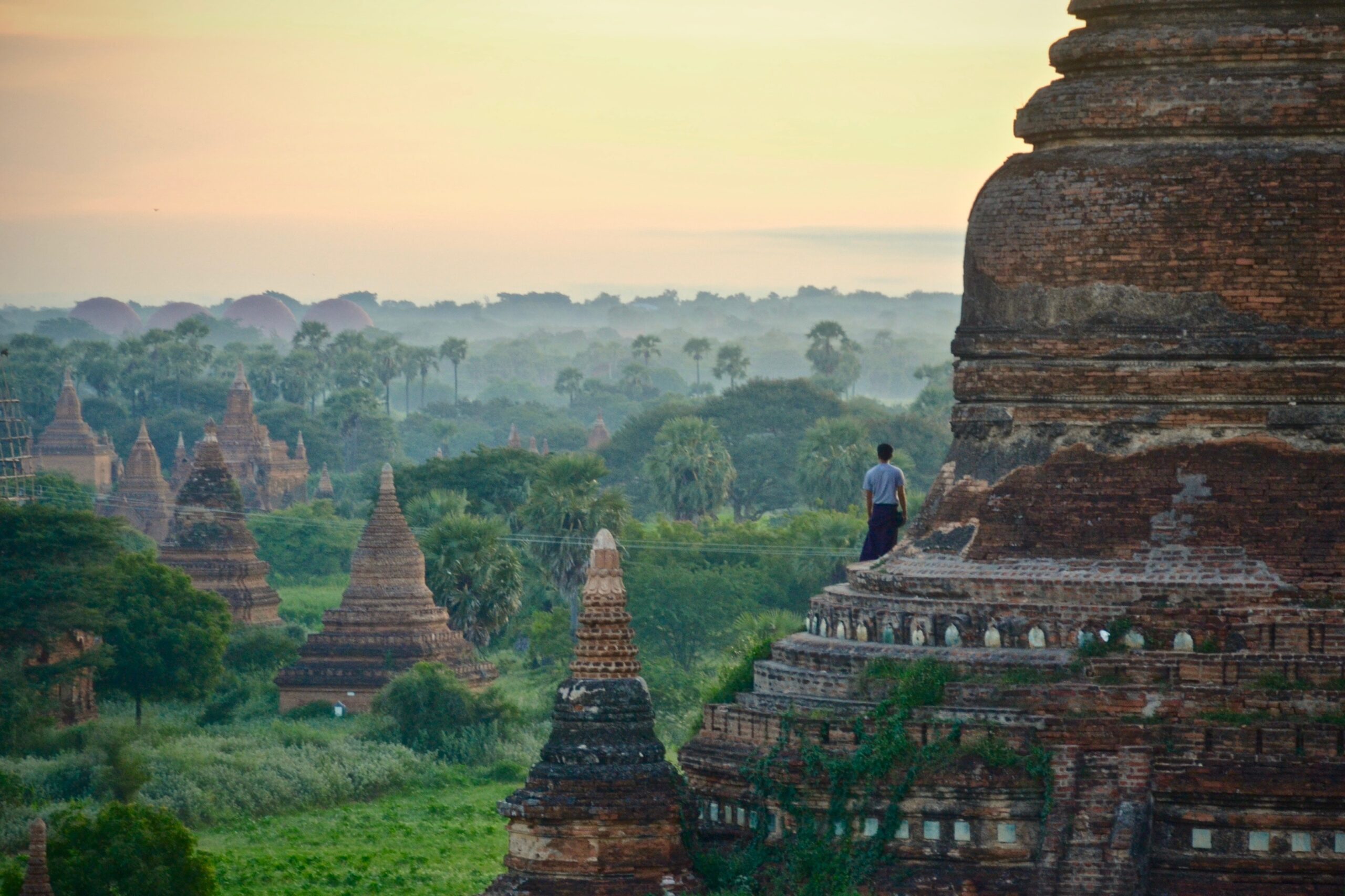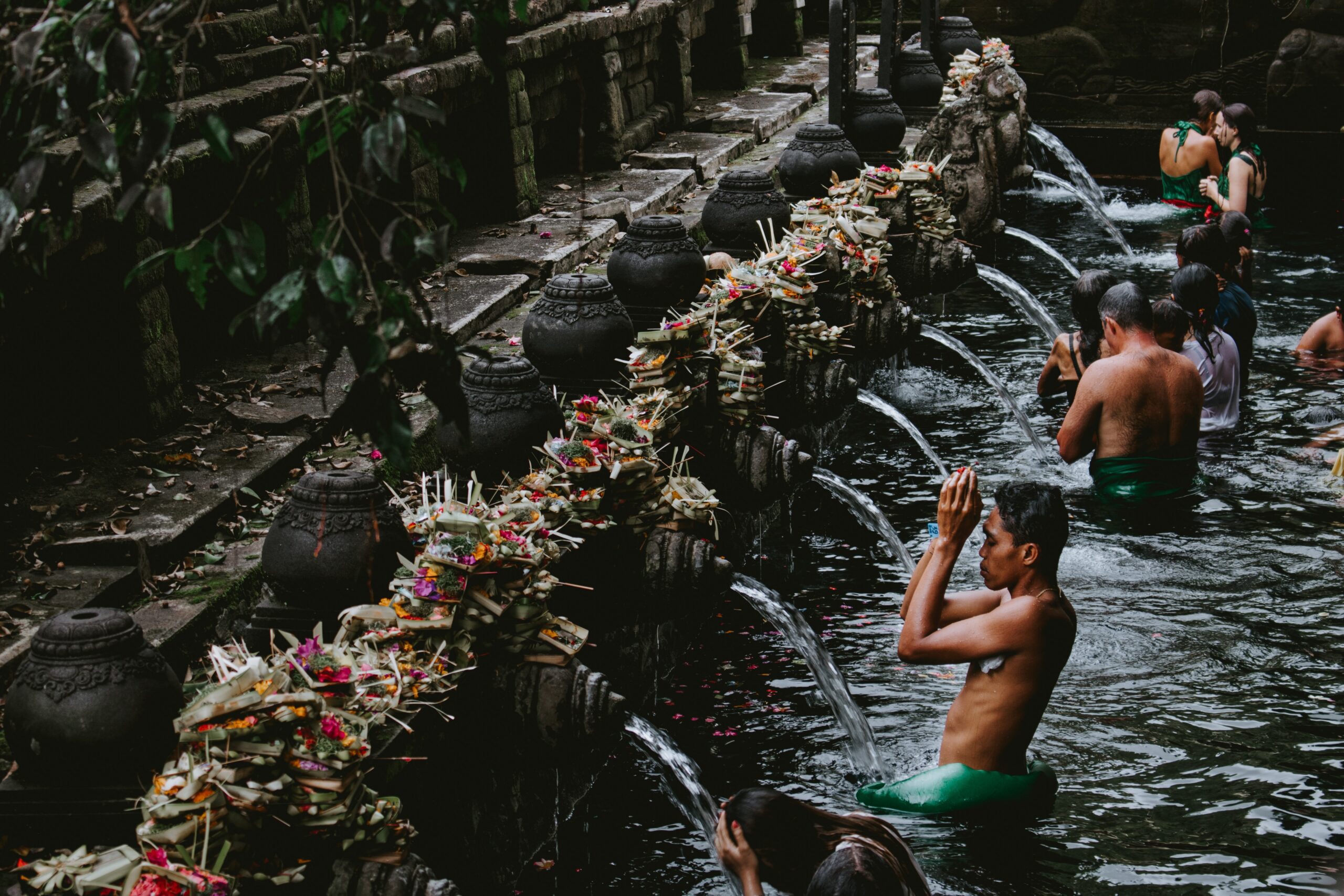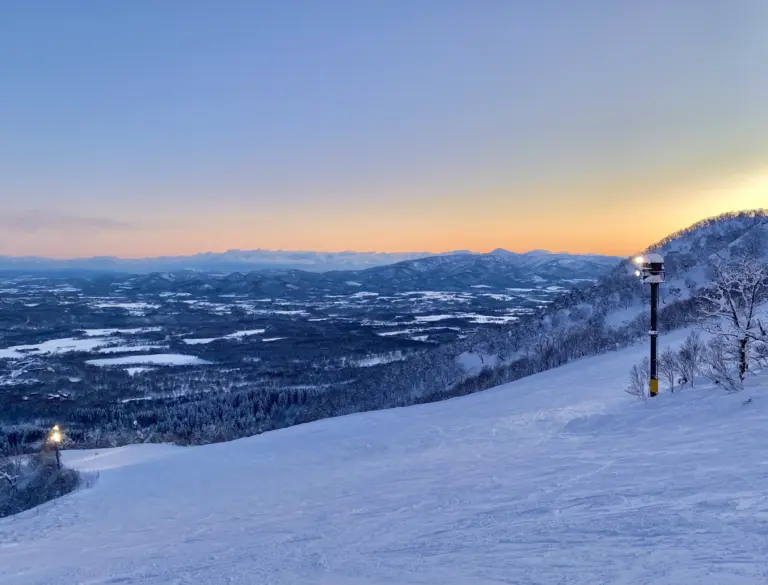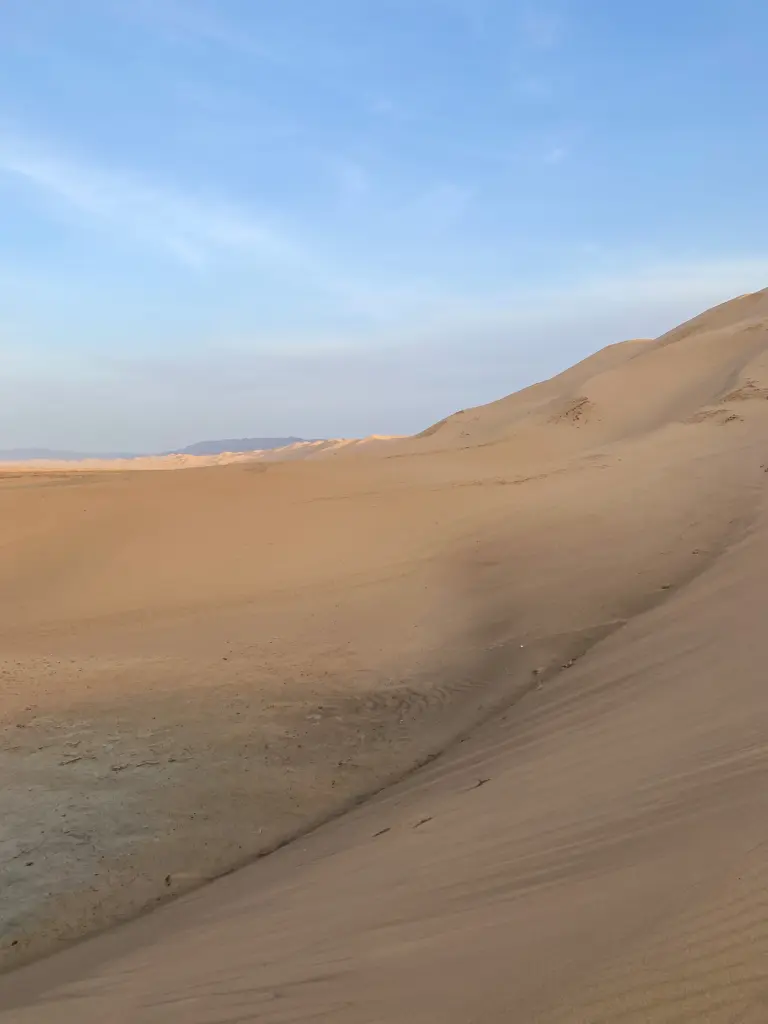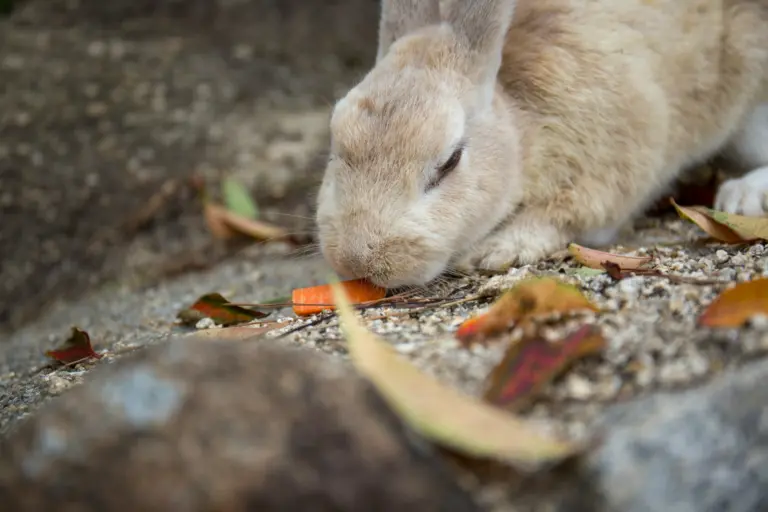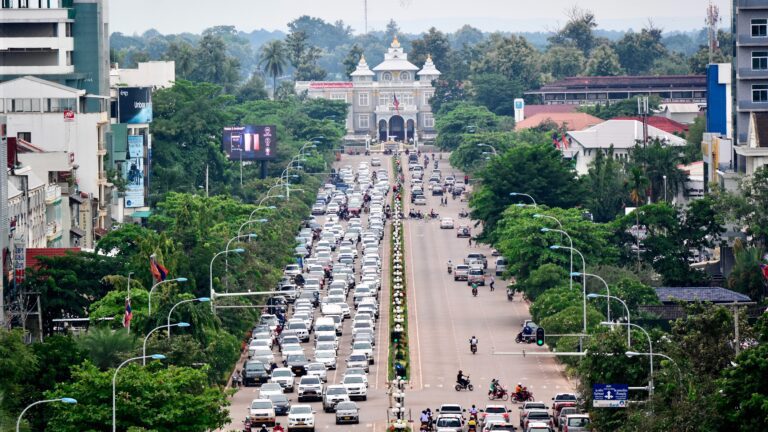A jewel in the East China Sea, Naha is a gateway to the enchanting Ryukyu Islands, where the sea and the seasons are part and parcel of daily life.
Naha is a city where age-old castles stand proudly beside contemporary buildings. The air is fragrant with the scent of tropical flowers and the tantalizing aroma of Okinawan cuisine, but it’s always the people that truly make this city shine.
Their warm smiles and laid-back attitude is really different from the rest of Japan as I’m sure you’ll notice. While most people skip out on Naha to explore the other Okinawan islands, there’s no doubt that Naha promises an unforgettable experience. For in Naha, every day feels like a celebration of life, culture, and nature.
So, pack your sunglasses and a sense of adventure, and let’s get to know Naha, where the spirit of summer always dances in the air.
Table of Contents
Toggle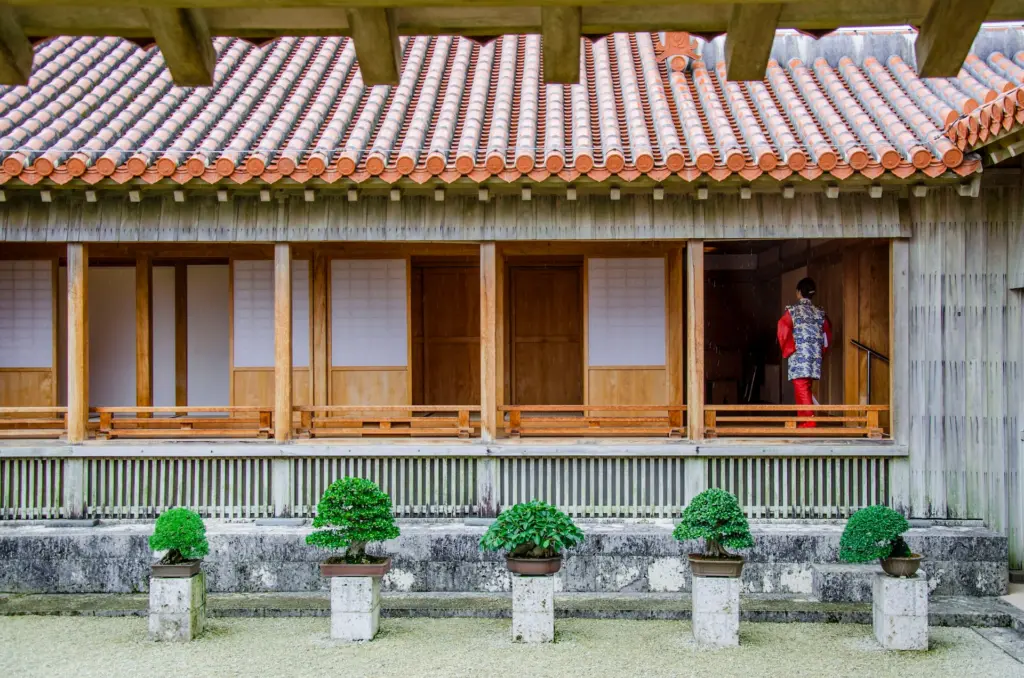
History of Naha
Naha’s history takes us back centuries to the time when it was the capital of the Ryukyu Kingdom.
This period, which began in the 15th century, marked Naha as a kingdom that thrived on its unique position, serving as a commercial bridge between Japan, China, and Southeast Asia.
During this era, the now-famous Shuri Castle was the residence of the Ryukyu kings. The influence of various cultures, especially Chinese Culture, is evident in the architectural styles and cultural practices that evolved in Naha during this period.
The Ryukyu Kingdom was formally annexed by Japan in 1879 during the Meiji Restoration, and the kingdom was renamed Okinawa Prefecture. Naha became the prefectural capital, marking a new chapter in its history.
The city faced its most challenging times during World War II, particularly in the Battle of Okinawa in 1945. Naha was almost completely destroyed, and the war left a profound impact on the city and its people. The post-war era was a time of reconstruction and rebirth.
Naha was rebuilt from the ashes, transforming into the modern city we see today.
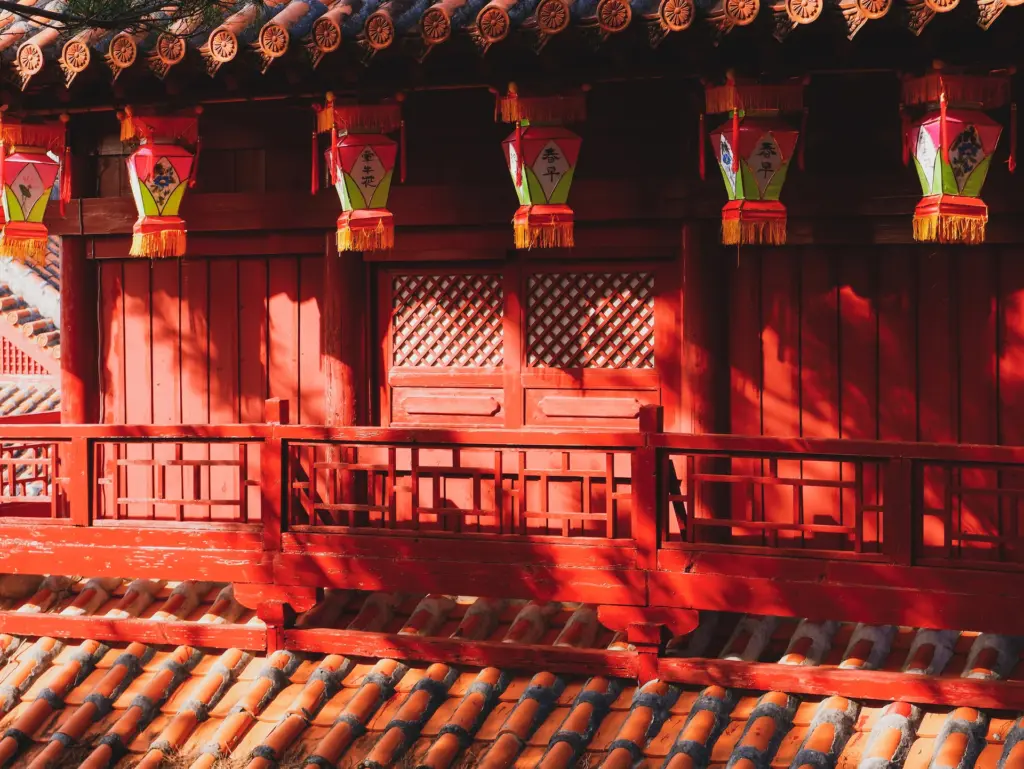
Ryukyuan Culture Overview
Ryukyu culture actually stands out distinctly from mainland Japanese culture.
Did you know Karate originated in the Ryukyu Kingdom? It evolved from indigenous fighting styles under Chinese influence, embodying a philosophy that balances physical discipline with spiritual growth.
There’s also the sanshin, a three-stringed instrument resembling a banjo, which is central to Okinawan music. Often accompanied by traditional Okinawan folk songs that tell tales of love, life, and the natural world.
While you may have heard of the Yukata and Kimono, the traditional attire of the Ryukyus, known as the bingata, is not to be missed. Bingata is a flamboyant colored fabric, often adorned with patterns of flowers, birds, and other nature-inspired themes.
If you’re intrigued by the Okinawan cultural heritage, a deeper exploration can be found in my detailed article on Ryukyuan Culture!
Top Things to Do in Naha
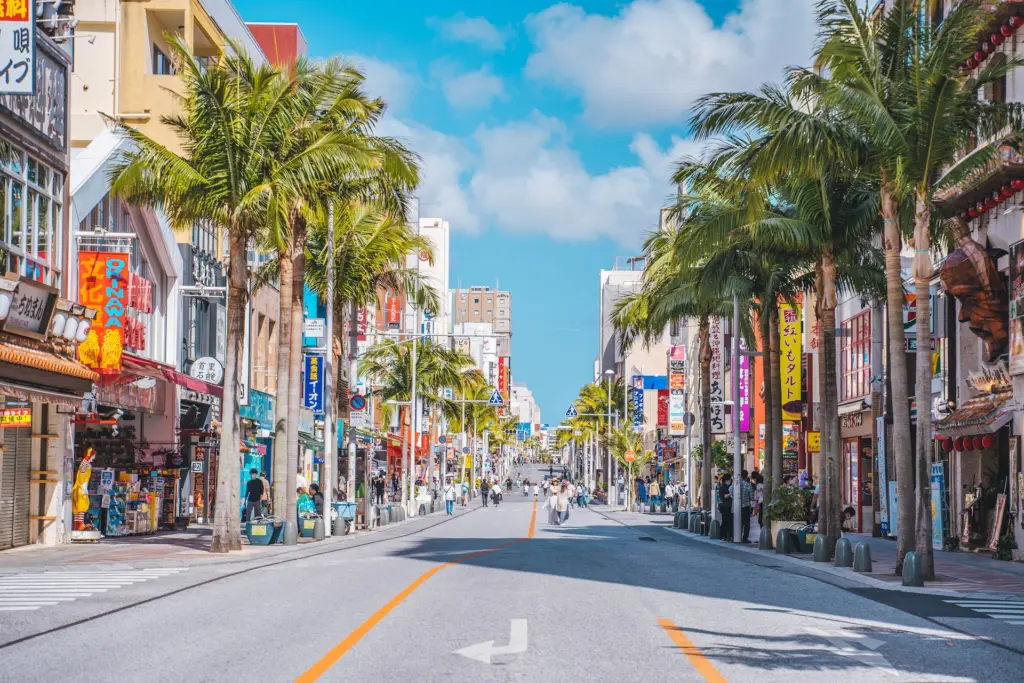
1. Walk down Kokusaidori Street
Kokusaidori basically translates to International Road. And in this 1.6 km (0.9 mi) shopping street, you’ll find two stone lions guarding the entrance and palm trees flanking both sides of the street. This is usually the first stop for tourists visiting Naha.
Following World War II, this area was at the heart of the American-occupied territory in Okinawa. The street was initially a hub for American soldiers, and over time, it evolved into a melting pot of Okinawan, Japanese, and American cultures. This unique blend is still evident today in the variety of shops, eateries, and entertainment options that line the street.
The street is also famous for its role in local festivals. The most notable is the Naha Matsuri, one of Okinawa’s largest festivals, featuring the traditional Tug-of-War, which is recognized by the Guinness World Records as the largest rope tug-of-war in the world. You can catch this event around October!
The street is a hotspot for authentic Okinawan cuisine, which is known for its unique ingredients and health benefits. After all, Okinawa is famed for having one of the highest life expectancies in the world, and the local diet, including dishes that can be found on Kokusaidori, is believed to contribute to this longevity.
So why not see what it’s all about?
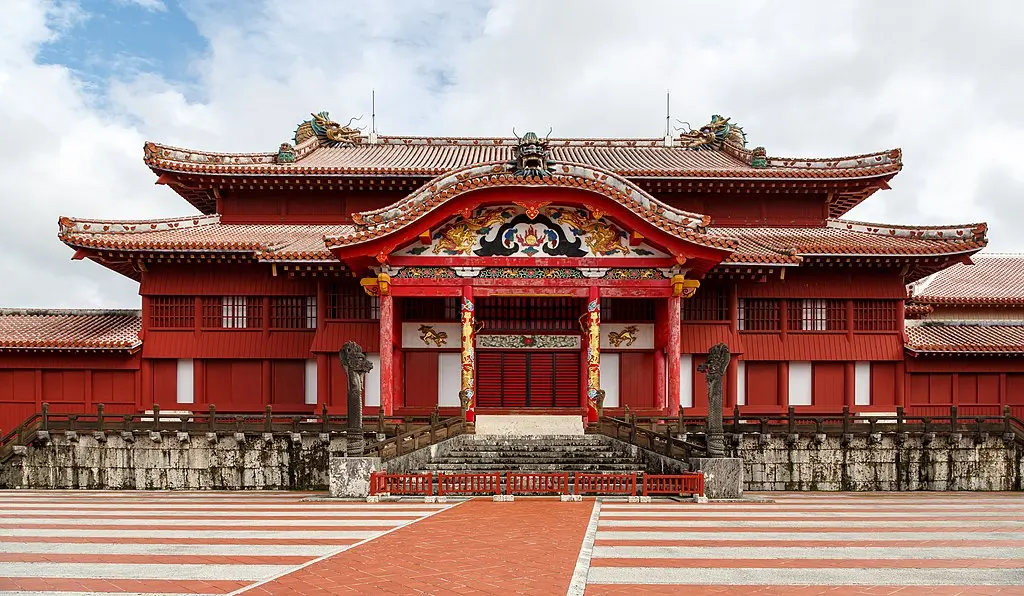
2. Marvel at Shuri Castle
Shuri Castle’s origins date back to the 14th century, though the structure underwent numerous reconstructions over the centuries.
The castle’s architecture is a stunning representation of Ryukyuan design, showcasing influences from Japanese, Chinese, and other East Asian architectural styles. This fusion creates a unique aesthetic that sets Shuri Castle apart from other Japanese castles.
One of the most distinctive features of Shuri Castle is its vibrant red color, a stark contrast to the typical hues of mainland Japanese castles. The red color, representing sacredness and nobility in traditional Ryukyuan belief.
The castle complex includes several important buildings and gates, such as the Seiden (Main Hall), and the Shureimon Gate which is adorned with the Chinese characters for “Shurei,” symbolizing the kingdom’s historical tribute relationship with China.
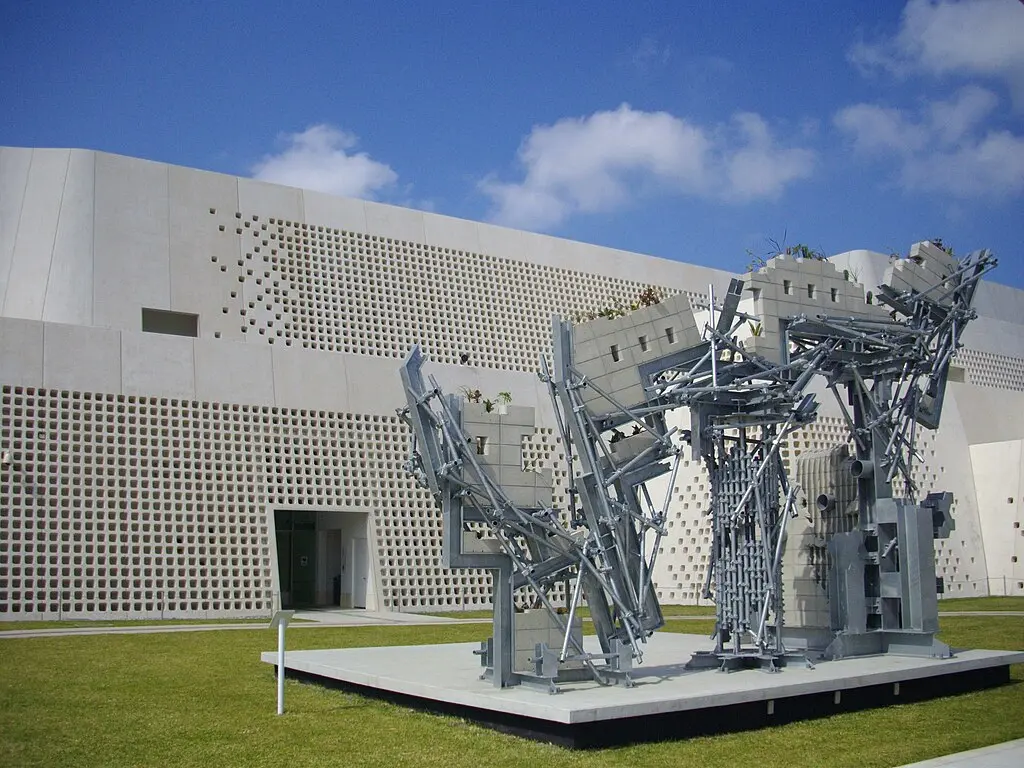
3. Visit the Okinawa Prefectural Museum
The Okinawa Prefectural Museum & Art Museum is a state-of-the-art facility that opened in 2007. A visit here is a must if you’re after a comprehensive look into the unique aspects of Okinawan history, arts, and nature. All for just 530 JPY!
One of the museum’s highlights is its extensive collection showcasing the Ryukyu Kingdom era. This collection provides insight into the political, cultural, and social aspects of the kingdom that once flourished on these islands.
The art museum section features a range of artworks, from traditional Okinawan art to contemporary pieces. The art exhibits often change, presenting works from local Okinawan artists as well as artists from across Japan and the world.
Another significant aspect of the museum is its focus on the natural history of Okinawa. The islands’ unique geographical position has resulted in a diverse range of flora and fauna, many of which are endemic to the region.
The museum complex itself, with its modern architectural design, seamlessly blends with the surrounding environment, reflecting the harmonious coexistence of nature and culture that characterizes Okinawa.
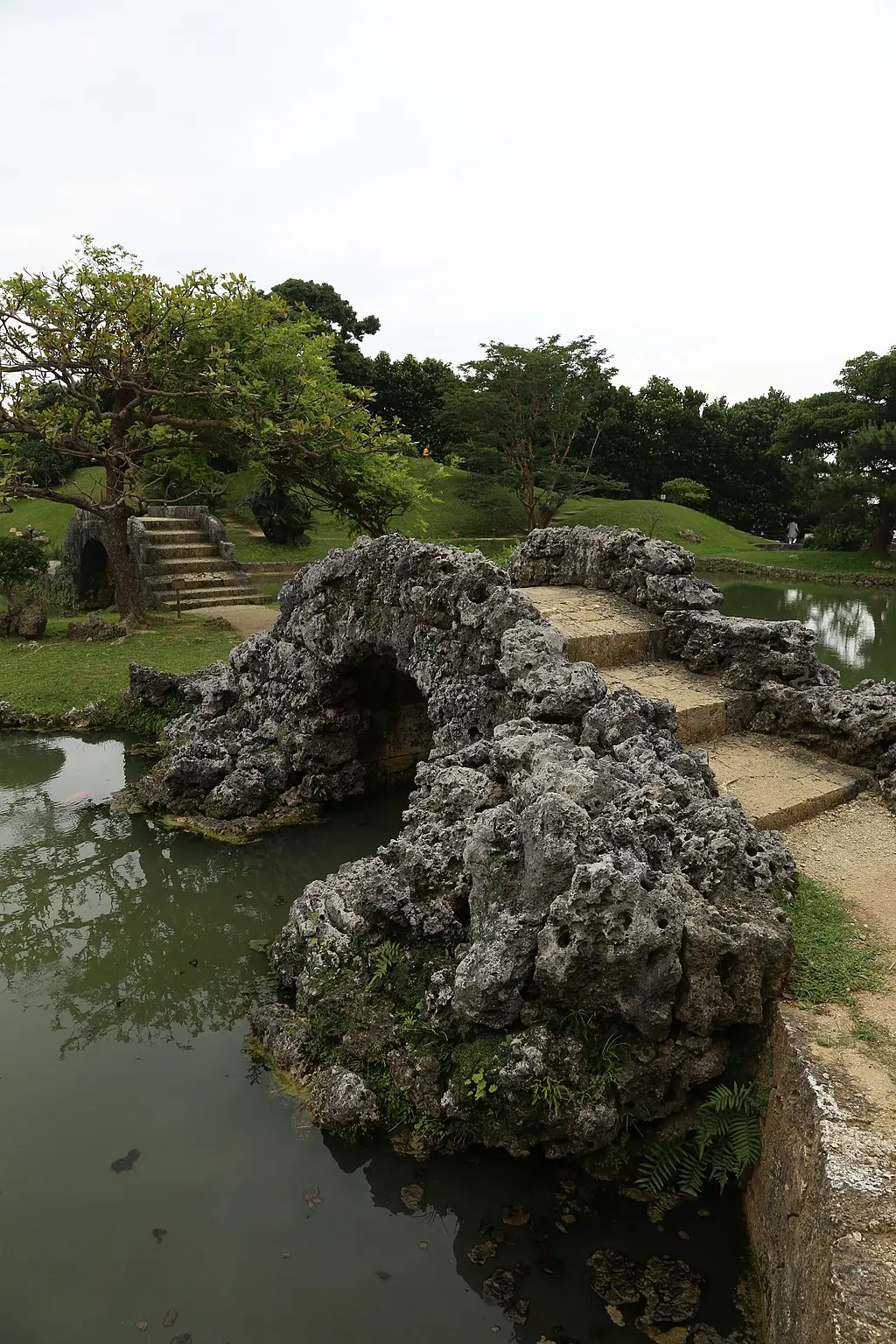
4. Stroll Around Shikina-en Royal Garden
Shikina-en Royal Garden was constructed at the end of the 18th century for the Ryukyu royal family, this garden is a beautiful example of traditional Ryukyuan landscape design, blending elements of Japanese and Chinese garden styles.
The garden was originally designed as a retreat for the royal family and their guests. Its layout is centered around a large pond, with a series of walking paths meandering through the lush, carefully manicured landscape.
The pond itself is a focal point, featuring a small island connected by an arched stone bridge, creating a scene that seems lifted from a traditional East Asian painting.
Shikina-en was almost completely destroyed during World War II but was lovingly restored to its former glory, reopening to the public in 1975.
In 2000, it was designated as a part of the UNESCO World Heritage Site that includes several other Ryukyuan Kingdom-related sites in Okinawa.
5. Try Out Potama Onigiri
Potama Onigiri is a popular onigiri sandwich shop in Okinawa, known for its distinctive and tasty pork tamago (pork and egg) rice sandwiches. I tried just two of these bad boys and they were enough to fill me up for the entire day!
This delightful dish combines the traditional elements of Japanese onigiri with a unique Okinawan twist. The sandwich features nori seaweed topped with a thin layer of rice, a Japanese omelet (tamago), and a slice of grilled Spam.
Spam has become a beloved ingredient in Okinawa, especially after its introduction during the American occupation. When combined with the healthy sushi rice and seaweed, along with the egg, it creates a juicy, salty flavor profile that has turned it into Okinawan soul-food.
The red Mizo Potama, with its sliver of savory Mizo paste, comes highly recommended for its addictive taste!
Priced at around 380 JPY, totally affordable and filling! Definitely, a must-try for anyone visiting Naha.
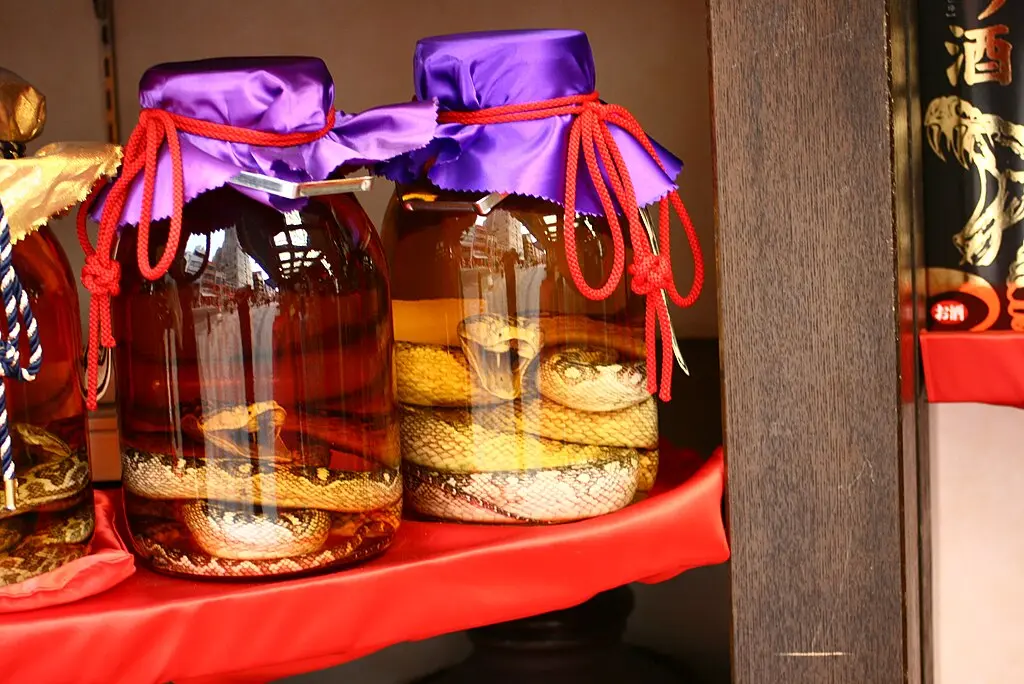
6. Taste Habushu
Habushu, also known as “snake sake,” is probably one of the most metal things you’ll find in Okinawa.
Habushu is made by infusing awamori (an Okinawan distilled spirit) with herbs and often a pit viper. As in you can literally see the snake’s corpse still inside the bottle! The snake is believed to impart health benefits and vitality to the drink. This practice has deep roots in traditional Okinawan medicine.
The process of making Habushu begins with the selection of a suitable snake, which is then cleaned and sewn shut to prevent decomposition. The snake is infused in awamori along with medicinal herbs and sometimes honey, giving the drink a distinctive taste.
Habushu typically has a strong kick, both in flavor and effect. It’s best to drink this one in moderation, folks.
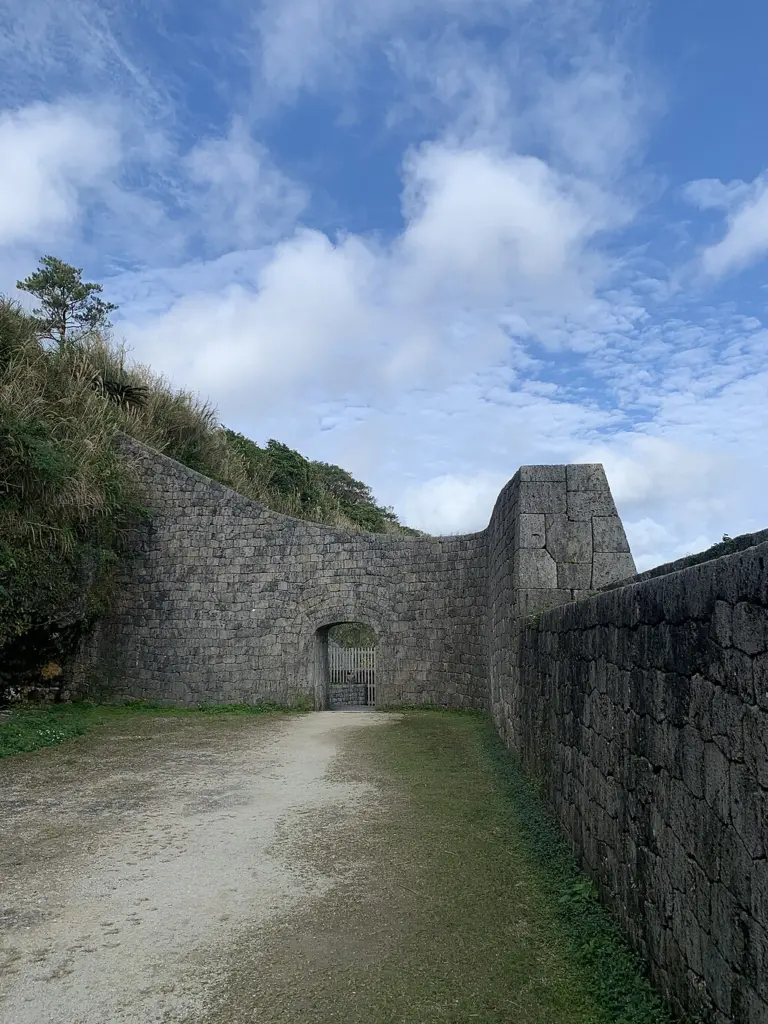
7. Explore the Urasoe Castle Ruins
One of the many castle ruins around the mainland, Urasoe Castle, dates back to the 13th century, and was once a grand structure and served as the residence of several Ryukyuan kings before the capital was moved to Shuri.
What makes the Urasoe Castle Ruins intriguing is the glimpse they offer into the pre-Shuri period of Ryukyuan history. The ruins are spread out over a large area, with remnants of the castle walls, gates, and foundations of buildings. As you walk through the site, you can imagine the grandeur of the castle in its heyday.
Perched approximately 140 m (460 ft) above sea level, the castle ruins are divided into two main sections, the Kogusuku and Migusuku. You’ll also find that the castle was constructed on a series of limestone cliffs, offering stunning views of the surrounding city and coastline. It makes for a breathtaking sidetrip if you have a car.
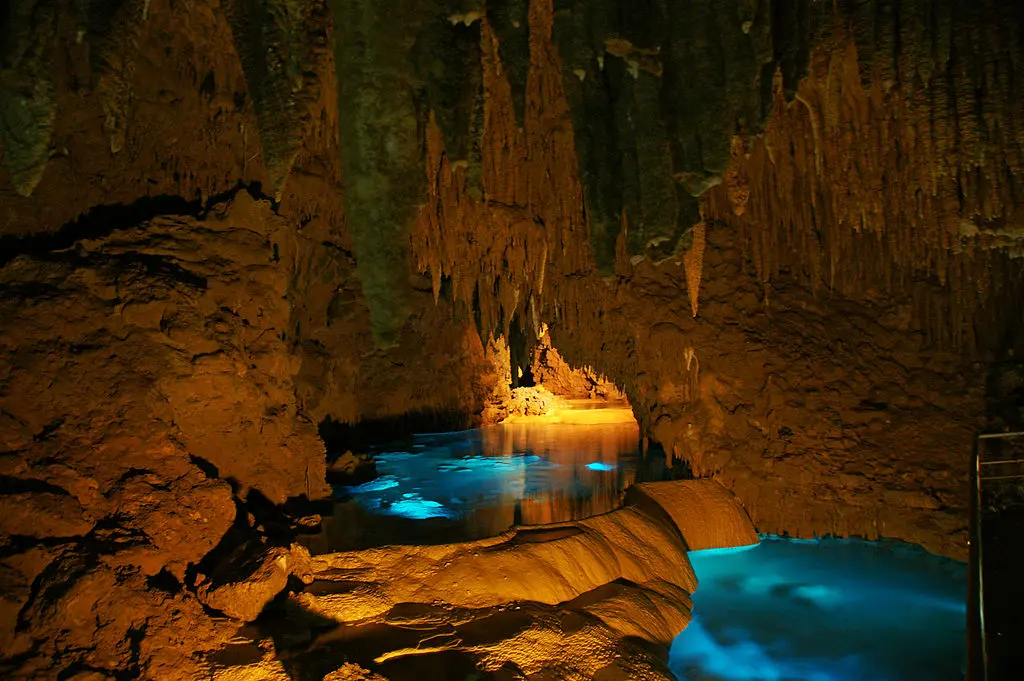
8. Experience Okinawa World
Okinawa World is a unique theme park that showcases the island’s natural beauty, culture, and history in a fun and interactive way.
The park’s main attraction is of course, the Gyokusendo Cave, the second longest cave in Japan! A most spectacular limestone cave, this natural wonder, formed over 300,000 years, boasts an impressive array of stalactites and stalagmites, illuminated by subtle lighting to enhance their beauty. It stretches for an impressive 5 km (3 mi), although only 890 m (0.5 mi) are accessible to the public.
Above ground, Okinawa World immerses you in the island’s culture and traditions. The park features a traditional Ryukyuan village, where you can see restored houses and workshops that depict Okinawan life in the past.
Another highlight is the Habu Park, dedicated to Okinawa’s indigenous and infamous venomous snake, the habu. Perhaps you can get a shot of habushu here is as well?
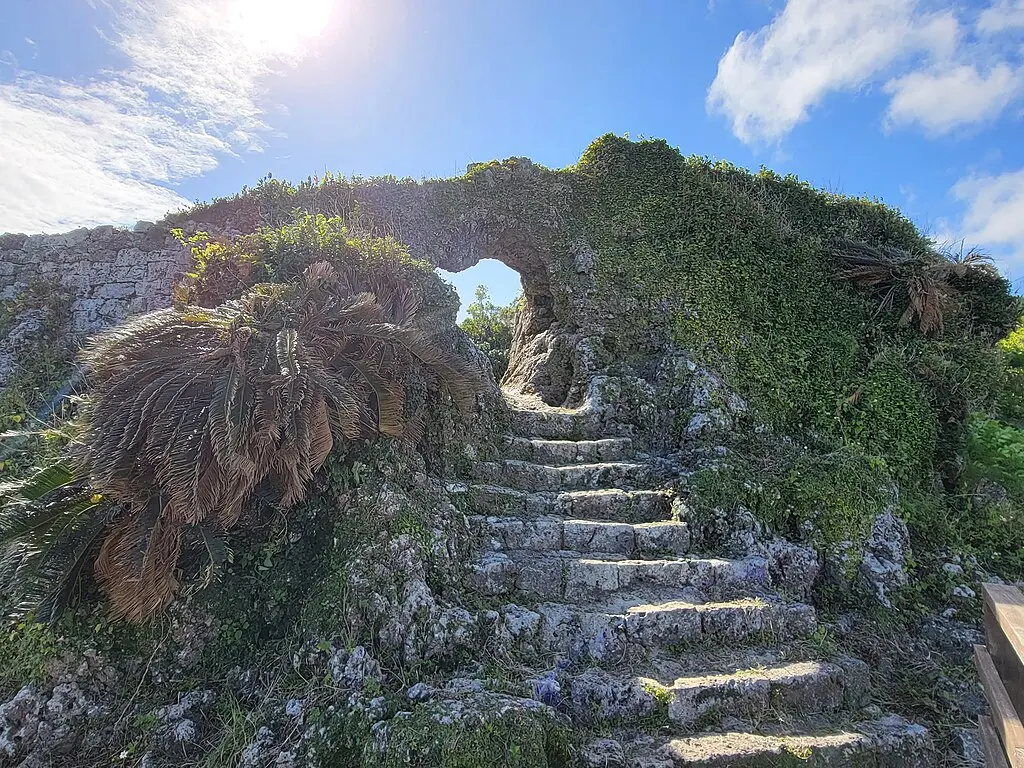
9. Admire the Tamagusuku Castle Ruins
Tamagusuku Castle is revered as the oldest castle on Okinawa, with a history intertwined with the creation goddess of the Ryukyuan religion, Amamikyu.
The ruins, now considered a sacred grove, were once the home of the Aji of Tamagusuku Magiri. These ruins provide a unique opportunity to follow in the footsteps of Ryukyu kings, who undertook agariumai, or “eastward pilgrimages,” to this and other sacred sites in the area.
According to local legends, Tamagusuku Castle was built by the deity Amamikiyu, who came from the utopian land of Nirai Kanai, far east of the sea. Amamikiyo is revered as the soleishin, or “ancestor spirit,” and is associated with the creation of the world and the introduction of rice cultivation.
The castle and the surrounding area are central to local religious practices and ceremonies, which often face east, towards Nirai Kanai, reflecting a special connection with the sun and its symbolism.
You can still see parts of the original ramparts on the hilltop. However, much of the castle’s lower sections were repurposed for constructing American bases after WWII, leaving only the foundations in these areas.
The stone gateway of the castle is particularly distinctive, with a round opening that aligns with the sun’s movements, allowing sunlight to beam through during the summer solstice and the warm light of the sunset during the winter solstice.
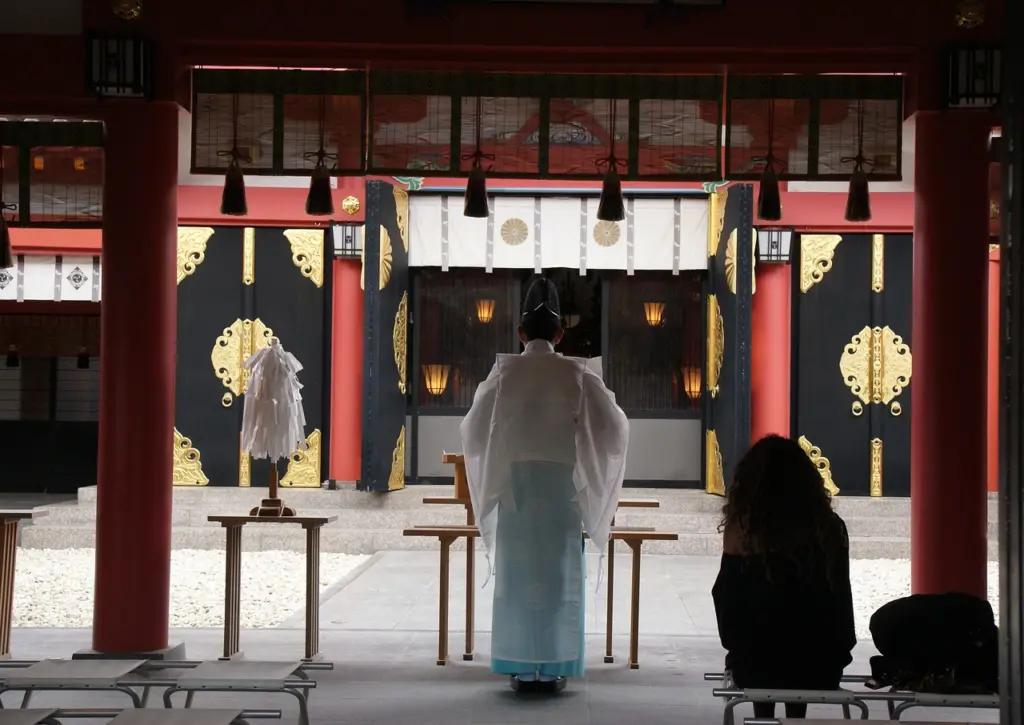
10. Pray at Naminoue Shrine
Naminoue Shrine holds the distinction of being the highest-ranking Shinto shrine in Okinawa. The name “Naminoue” literally translates to “above the waves,” aptly describing its picturesque location.
Historically, the shrine was a sacred place for the native Ryukyuan religion, dedicated to Nirai Kanai, a mythical place from where blessings were believed to come. With the introduction of Shintoism in Okinawa, the shrine was assimilated into the Shinto faith, becoming a syncretic fusion of local and Japanese spiritual traditions.
Another of the unique aspects of Naminoue Shrine is its connection to the sea. It’s considered the guardian of seafarers and fishermen, just like Ebisu, one of the Seven Lucky Gods in Japanese culture.
Best Tours in Naha
Here are some of the most popular and fun experiences you can join from Naha:
- North Okinawa Sightseeing Tour & Churaumi Aquarium – Visit Okinawa’s famous landmarks including Churaumi Aquarium, Kouri Island, and Cape Manzamo. Enjoy the scenic island landscape of Okinawa.
- Kerama Islands Half-Day Whale Watching Tour – Marvel at whales and dolphins playing in the crystal-clear waters of Okinawa on an unforgettable whale watching trip that offers a convenient pickup service from Naha.
- Kerama Island Snorkeling Day Trip with Lunch – Experience the crystal-clear waters of the Kerama Islands and swim next to tropical fish on a full-day snorkeling tour that includes a roundtrip pickup service and lunch.
- Day Trip to Tokashiki Island with Lunch – Enjoy round-trip transfer from Tomari Port by ferry on this day tour. Swim in clear sea waters. Encounter the beauty of nature on the Kerama Blue.
- Kerama Islands Full-Day Intro-Diving Trip – Learn how to dive on the crystal-clear waters of the Kerama Islands, filled with colorful fish and corals, on a full-day trip that includes roundtrip hotel pickup service and lunch.
Best Beaches in Okinawa
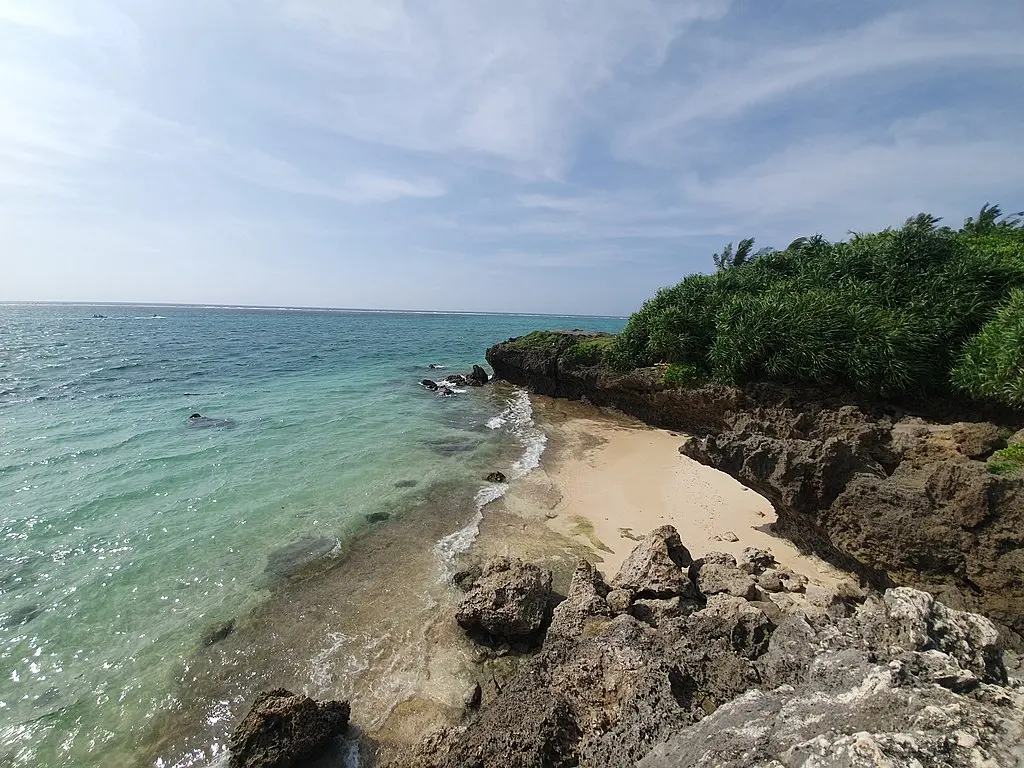
11. Moon Beach
Moon Beach, named after the nearby Hotel Moon Beach, offers a distinctively convenient and family-friendly beach experience. Unlike secluded beaches, Moon Beach’s charm lies in its integration with the hotel’s amenities.
The beach itself, stretching 150 meters, is meticulously maintained, providing a clean and inviting environment for sunbathing and relaxation. The sand is white, fine, and soft.
I was traveling with my Slovak friend here who hosted us through Couchsurfing when we visited Hakone before. On our first day in Naha, Moon Beach was the first place we stopped by. We simply spent time sunbathing and exploring the nearby rocky cove.
Moreover, Moon Beach’s location within a hotel resort means that you’ll have immediate access to a variety of water activities and facilities. From jet skiing to snorkeling!
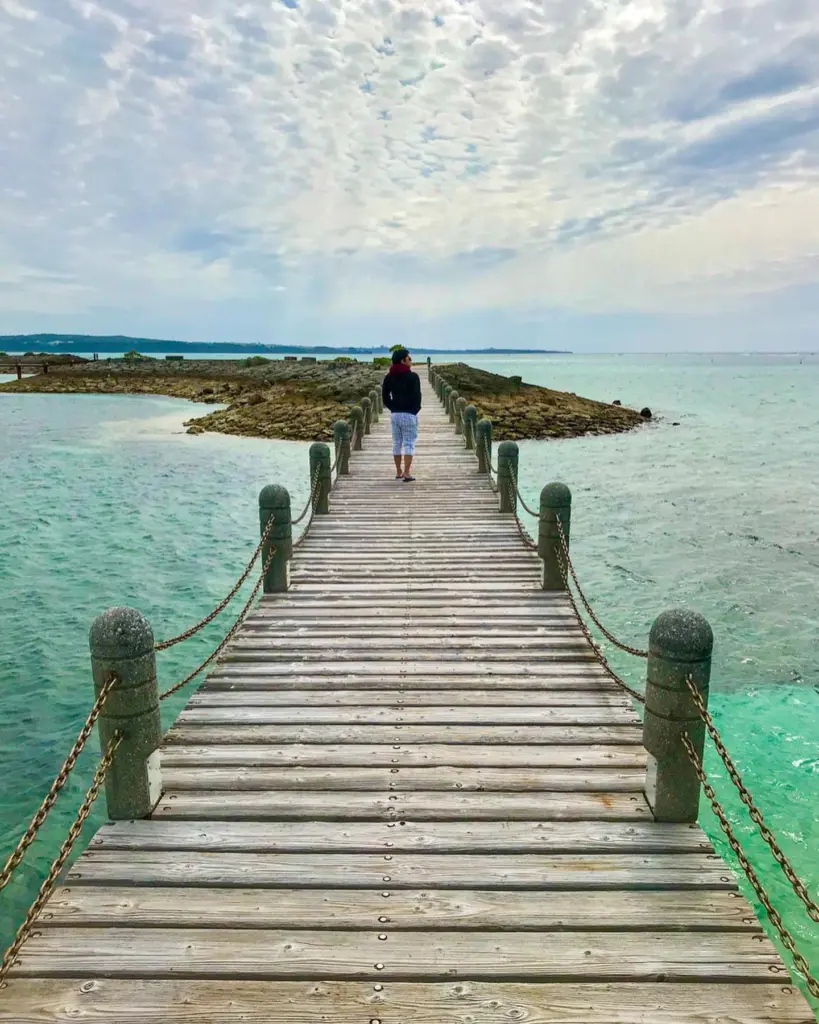
12. SunMarina Beach
Sunmarina Beach, associated with the Sunmarina Sheraton Resor, is renowned for its crystal-clear waters and expansive sandy shores. This picturesque beach, known for its stunning natural beauty, stretches approximately 300 meters along the coast, and even a bit more after that.
The beach’s width varies, but it’s sufficiently broad to accommodate both active beachgoers and those seeking a quiet spot to unwind.
To be honest the whole area was huge and breathtaking with turquoise waters and wonderful cloud formations, the pictures we got that day were marvelous.
We went around the area and even inside the restricted zones, we climbed the lighthouse and walked across the wooden bay walk seeing different kinds of fish swimming under the shimmering waters, including a fugu!
We were in for a bigger surprise as we saw through the bushes that the beach does in fact stretch further for a couple of more kilometers. We walked and walked and the landscapes seemed to change every few meters. The beach was very dynamic with lots of different rock formations, caves and wildlife. Probably one of the best beaches in Naha.
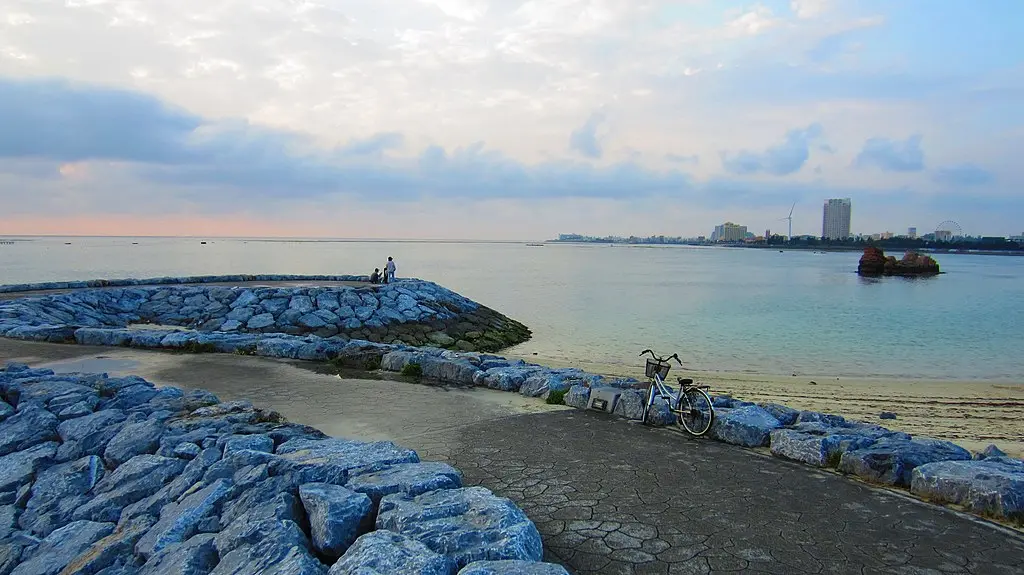
13. Araha Beach
On the second day, I went to Araha Park. Here you’ll find Araha Beach, a 600-meter white sand beach, adjacent to it. It’s a much more lively area, with people jogging alongside their dogs around the park and the usual beachgoer activities happening near the surfside.
The park features an iconic life-size pirate ship, which is a hit with children! It’s a much more peaceful and laid-back vibe here and I stopped by here since it was on the way to Manza Beach.
Of course, it was going to be a beach-hopping day.
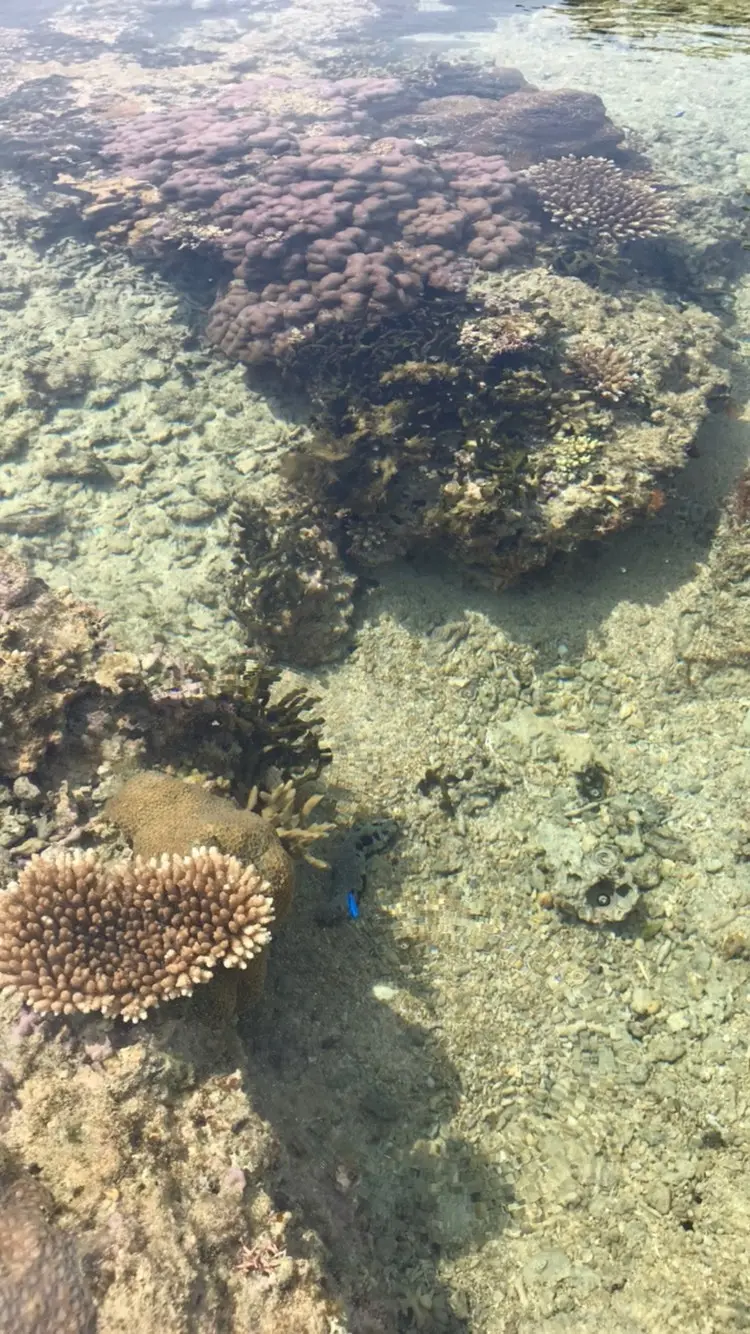
14. Manza Beach
Manza Beach, situated in front of the prestigious ANA InterContinental Manza Beach Resort, is a gem among Okinawa’s beaches. This 300-meter long beach, like all other beaches around Naha, offers soft sand and crystal clear waters.
The water quality at Manza Beach is exceptional, with its clarity being a highlight for those who enjoy swimming and snorkeling. In fact, you don’t even need to snorkel to see the wildlife swimming around you.
There was a lot of sea life swimming about, the most interesting one was the sea rabbit that sprayed a red smokescreen when I accidentally touched it, I waded through the water to reach the island on the other side, the rocks were really spikey so it’s better to bring slippers, not to mention the spiky sea urchins littered all around.
It was fun but after a while, I decided to go to where Eliska who was chilling at Cape Maeda.
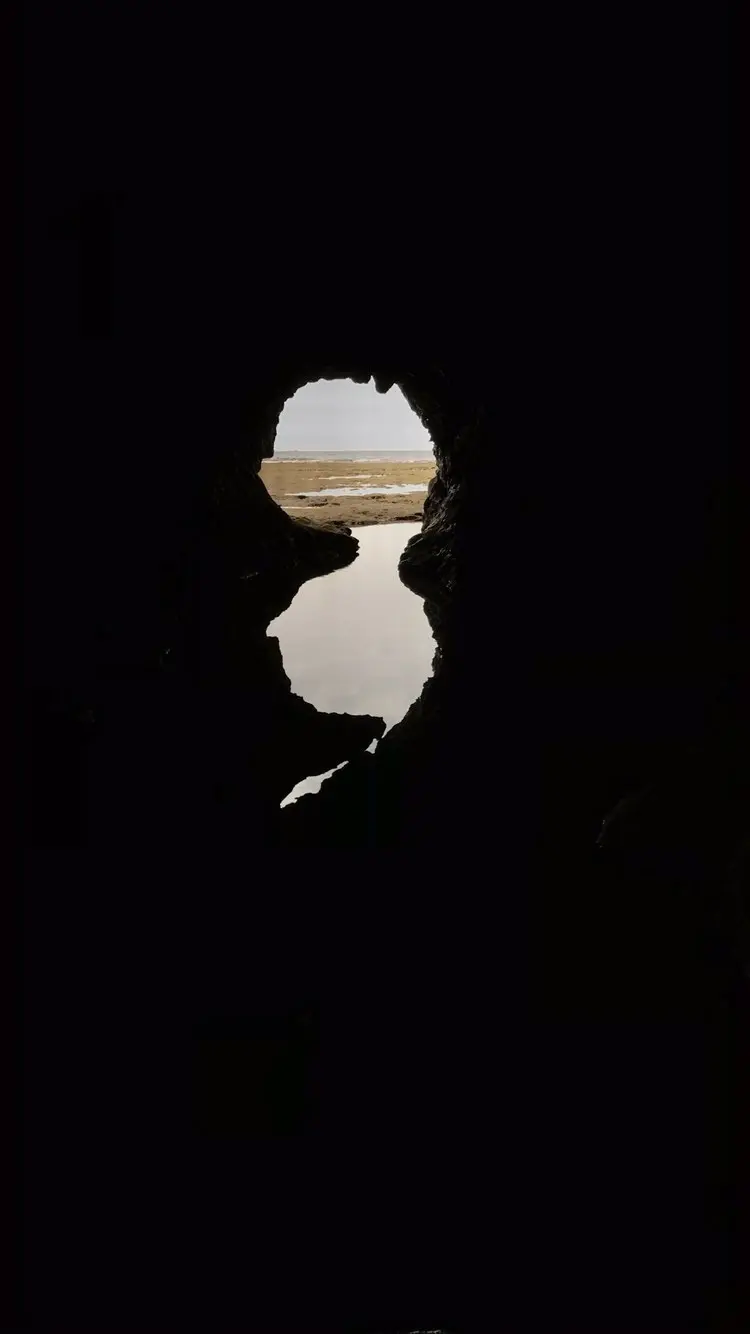
15. Cape Maeda
Cape Maeda proved to be the absolute best place in Okinawa mainland, in my humble opinion.
It was lowtide but the ocean left a lot of leftover springs in its wake, there were caves and alcoves that housed a myriad of colorful fish and sea creatures, it was like a natural open-air aquarium.
I jumped from one puddle to the next, taking a peak through the crystal clear water of the ecosystem happening below it. It was quite tempting to jump right in but at the same time, the water seemed a bit too cold.
There were unique rock formations all around the beach, I have never seen anything like it.
After exploring for some time, we then went up to the cape area, it was quite rocky but the view of the ocean was spectacular. As the sun set, we grabbed some pizza for dinner at the nearby restaurant.
Another attraction near Cape Maeda is the Blue Cave, about 100 meters to the south-east. This underwater cave is bathed in a stunning blue light, created by the sun’s rays reflecting through the sea and into the cave, creating a surreal scenery.
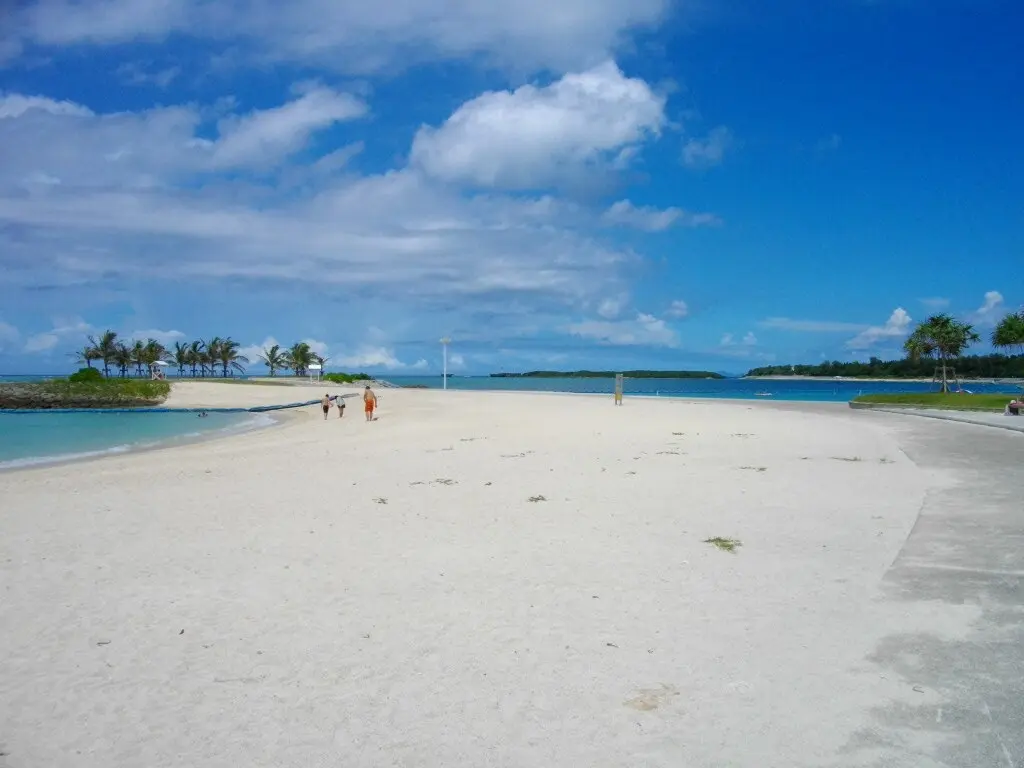
16. Emerald Beach
Emerald Beach is a man-made wonder located within Ocean Expo Park. Adjacent to the famous Churaumi Aquarium.
The beach’s most striking feature is its clear water, which showcases a stunning gradation of emerald green hues. This vivid coloration gives Emerald Beach its name.
Spanning a large area, Emerald Beach is segmented into three different zones, each spanning a length of 150 meters. These zones ensure that all visitors, whether they are looking to relax, swim, or play, can find a spot that suits their needs.
17. Okuma Beach
Okuma Beach is found within the JAL Private Resort Okuma. A slice of paradise that stretches for about 1 kilometer and is enveloped by stunning natural scenery.
Surrounded by lush greenery and tropical flora, Okuma Beach feels like a secluded oasis.
Whether it’s camping near the shoreline, taking a leisurely bike ride along the coast with views of the East China Sea, or simply lounging on the beach for a tranquil break, Okuma Beach provides an ideal backdrop for a variety of outdoor experiences.
Where to Stay in Naha
Making Naha a base can be particularly strategic considering its convenient location and access to modern facilities. If you’re not after staying in the high-class resorts near the beaches, Naha is an excellent alternative that still boasts amazing nature and culture. Here are some of the most recommended places to stay:
Best Hotels in Naha:
- Rembrandt Style Naha – stands out as an appealing choice for travelers, this 3-star hotel boasts air-conditioned rooms with free WiFi and private bathrooms, complemented by a restaurant and private parking on-site. You can enjoy amenities like flat-screen TVs and complimentary toiletries in each room. The hotel’s bilingual staff, proficient in both English and Japanese, offer round-the-clock assistance at the front desk.
- hotel androoms Naha Port – part of the Solare Hotels and Resorts chain, hotel androoms offers a comfortable stay with air-conditioned rooms featuring modern amenities such as flat-screen TVs, slippers, and a private bathroom equipped with a shower, free toiletries, and a hairdryer. The hotel enhances the experience with free bikes, WiFi, and an on-site restaurant.
- Hotel Grandconsort Naha – presents a convenient location for travelers, this 4-star hotel offers a range of amenities including a shared lounge, 24-hour front desk, and complimentary WiFi. You’ll also have access to private parking. The air-conditioned rooms are well-equipped with a desk, electric tea pot, safety deposit box, flat-screen TV, and a private bathroom with a bidet. Each room is also furnished with bed linen and towels for added comfort.
Best Hostels in Naha:
- Myplace Guest House – a distinctive stay in Naha, that’s operated by a well-known diving shop. It’s ideally located for visiting the Kerama Islands, with activities like scuba diving, snorkeling, and parasailing available at discounted prices. The accommodation includes a fully equipped shared kitchen, a spacious living area with hammocks, and various room types suitable for solo travelers to groups. Additional amenities include free WiFi, and private parking.
- Abest Cube Naha Kokusai Street-Cabin Type Hotel – a newly opened property that features compact, well-appointed bedrooms and is dedicated to providing a friendly and comfortable experience. It stands out with its breakfast system and a bar that stays open until late midnight, offering live programs and games for entertainment. The hotel provides free WiFi throughout and includes a shared bathroom for each room, a flat-screen TV, and a 24-hour front desk. You can also enjoy a complimentary breakfast.
- Santiago Guesthouse Naha – offers a welcoming and friendly atmosphere. The guesthouse has been fully renovated, embracing Japanese style and design, creating a harmonious environment. It’s a great spot for travelers seeking a home-like experience while enjoying the unique charm and culture of Okinawa.
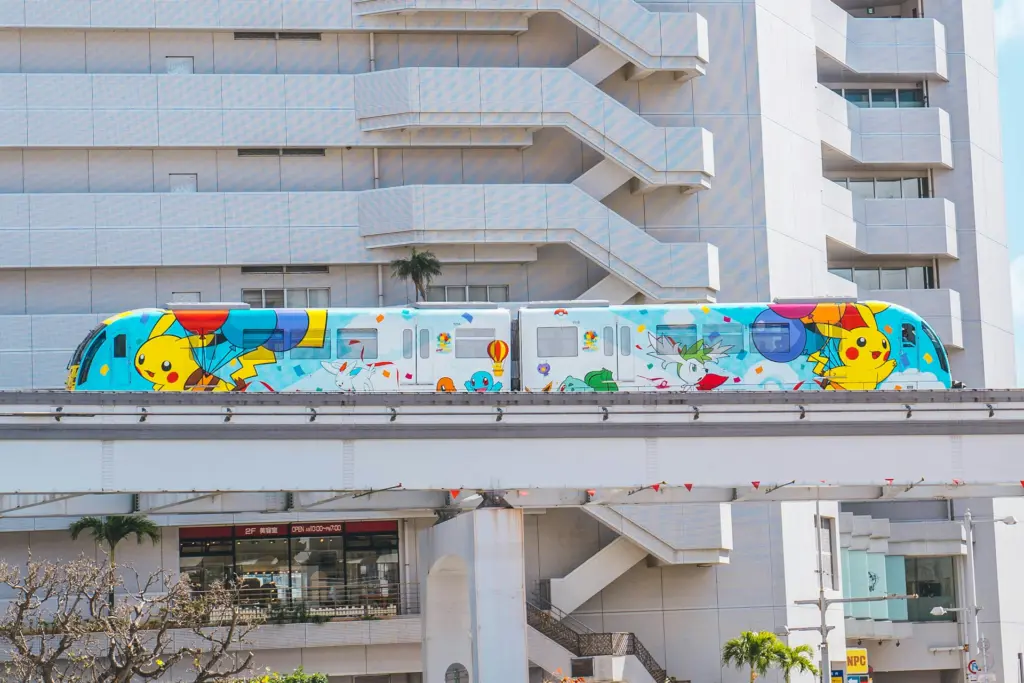
How to Get Around Okinawa Mainland
Here’s a guide to navigating Okinawa Mainland effectively:
Rental Cars: Renting a car is one of the most convenient and most recommended ways to explore the Mainland, especially if you plan to go beach hopping and reach the norther region. The island has well-maintained roads and scenic drives, such as the coastal roads offering beautiful sea views.
Buses: The bus network in Okinawa is extensive and covers most tourist attractions and major areas. We actually just used buses to visit the beaches but they do take time, the costs add up, and the schedules operate in “island time” which was something we weren’t used to compared to the rest of Japan.
Monorail (Yui Rail): In Naha, the monorail is a convenient option for quick and easy travel to major spots like Naha Airport, the city center, and Shuri Castle. While the monorail is limited to Naha, it’s very efficient for exploring the city.
Taxis: Taxis are available throughout Okinawa and are a reliable but more expensive option for getting around. They are particularly useful for late-night travel.
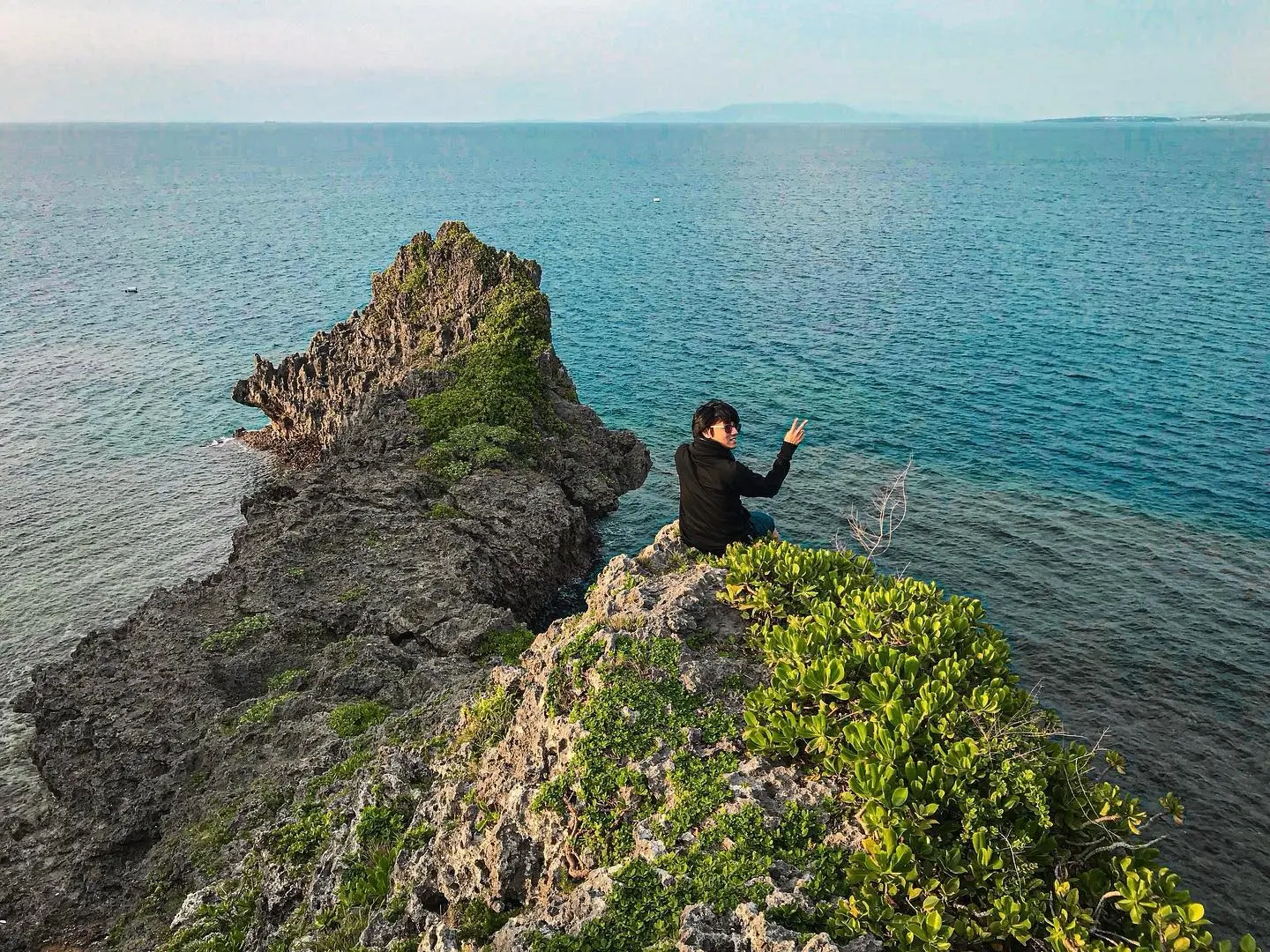
Best Time to Visit Okinawa
The best time to visit Okinawa is during the late spring months of April and May, or the autumn months of October and November. During these periods, the weather is most favorable and the crowds aren’t too hectic.
In late spring, temperatures range from 20°C – 25°C (68°F – 77°F), providing a comfortable climate for outdoor activities like beach visits and snorkeling. The cherry blossoms in Okinawa bloom earlier than in the rest of Japan, making late March to early April particularly scenic. However, keep in mind that late April and early May coincide with Golden Week, the busiest travel period in Japan, so it’s better to go before or after that period when prices aren’t bloated.
Autumn, particularly October and November, is another great time to visit. The weather is mild, with temperatures typically between 21°C – 28°C (70°F – 82°F). The typhoon season usually ends in early October, leading to clearer skies and calmer seas.
Summer in Okinawa, from June to September, is hot and humid, with temperatures often exceeding 30°C (86°F). While it’s the most popular time for beach activities, it’s also the peak of the typhoon season. During this time, the whole beach would be covered with people.
Winter, from December to February, sees cooler weather, with temperatures ranging from 15°C – 20°C (59°F – 68°F). While it’s not ideal for swimming and sunbathing, it’s a comfortable time for sightseeing and experiencing local festivals.
When planning your trip, be sure to get travel insurance to cover any unforeseen circumstances such as trip cancellations or medical emergencies. Travel insurance can provide a safety net, allowing you to enjoy your Okinawa trip with peace of mind.
Plan Your Trip to Okinawa | Best Travel Resources
Book Your Accommodations
- Booking.com – the world’s leading online booking platform for accomodations around the world, they have an extensive amount of available listings with zero booking fees and best price guarantees.
- Hostelworld – a backpacker’s best friend, Hostelworld has the largest collection of hostels and guesthouses for affordable prices.
Don’t Forget Insurance
- SafetyWing – from Nomad Insurance, an insurance by nomads for nomads. They understand our lifestyle well and have really comprehensive and flexible plans that cater to any traveler.
Find Cheap Flights
- Kiwi.com – my go-to for booking and finding the cheapest flights and it’s helped me save tons of money. They do virtual interlining which is connecting flights from airlines that do not codeshare, so you can find routes that you wouldn’t be able to find normally.
Join Tours & Activities
- GetYourGuide – is one of the best places to find unique tours and activities. I found that it’s an excellent way to meet fellow travelers and create fond memories. They are not only limited to tours as they also offer niche services such as skip-the-line tickets or private transfers.
Catch a Ride
- Rentalcars.com – nothing beats the freedom of the road, Rentalcars.com is the world’s largest online car rental service. They operate across 160 countries so they’re the perfect partner to work with if you find yourself wanting a ride.

